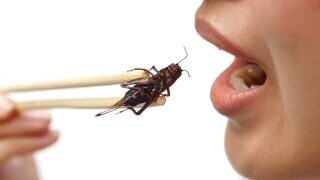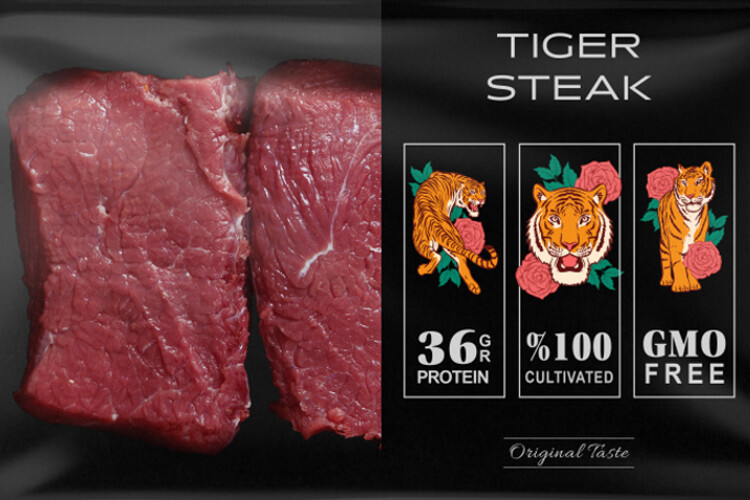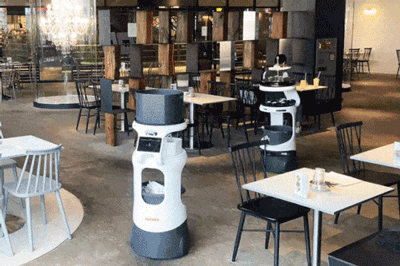Cracked's Eatin' Weird - 5 Food Advances Too Silly For Sci-Fi

Ever since Lucian of Samosata wrote the first science fiction in the second century CE, popular sci-fi has become progressively less imaginative. It's especially true in the culinary realm, where cookie-cutter space operas and dystopias only serve noodles or indeterminate slop. These post-Lucian incarnations underestimate human creativity and fail to answer meaningful questions.
Like, what will we eat after an antsy or astigmatic dictator hits "Launch All" in the Smart Nuke app available on iPhone and Pixel? How will our fatter society escape the tyranny of current dieting practices? Can we repurpose edible materials to build future cities?
Don't Miss
The answers are wilder than anything glimpsed on Bespin or in even the most unsettling salvia-induced fancies.
Tooth-Attached Food-Tracking Sensors
Tracking food consumption is among the biggest hurdles to healthier eating. Even those eager to reduce their candy-apple consumption to three per day are daunted by the formidability of writing it down.
Plus, weighing food!? What? How the hell do you weigh food? Before cooking? After? Do you… strain it from the toilet water to calculate the exact amount your body has assimilated? These are all very important questions with no discernible answers.
Calorie counting is equally befuddling. Sure, info on all the world's comestibles is available at the flick of a finger through easy-to-use tracking apps. But is this a Daikon radish or a Japanese Hummingbird radish? Does Calorie King correct for these quinoa nuggets being in Scooby-Doo shapes? You know what, screw this, it's candy apple time.
Luckily, Tufts University School of Engineering has invented a chip that attaches to one's tooth and could eventually provide real-time tracking of dietary intake.

Once the chip detects a certain substance, like salt, it shifts its electrical properties to transmit the accompanying radio frequencies. When it detects Red Lobster's Endless Dynamite Shrimp, for example, it sends the appropriate radiofrequency signal for "raccoon meat and veins" to your phone or other device.
The sensor can track salt, alcohol, and glucose, which form the foundation of the working American's food pyramid. But there's theoretically no limit to what other nutrients or drugs it will be able to detect, allowing you to check that your loved ones have taken their anti-psychotic meds. Or how much absinthe those psychotic loved ones have consumed.
It also has excellent Jetsons-1984 potential. It could one day ensure that citizens limit themselves to their allotted 40 grams of daily cricket gruel. Also, did The Jetsons feature any overweight characters? I always assumed it was due to a Soylent Green-type scenario. Over-consumers would be quietly hauled away to windowless facilities to produce cogs and a nutritious, pinkish paste—a special treat for the upstanding citizens who adhere to their quotas and report their over-consuming neighbors.
Consequently, Googling "fat Jetsons" was a grave, grave mistake. Obese sweaty Jane on a treadmill may not be overtly sexual, but it is absolutely overtly sexual.
Mushrooms May Be Everywhere (Not Just On Your Plate)
Modern sci-fi inspires multiple questions. First, did people write this, or is this the cumulative work of 50 typewriting chimps inside an abandoned Macy's? Another critical question, where are all the mushrooms?
Fungi are hardy, doomsday-proof, and have great future potential. Not just for eating, but for building. Exampled by Blast Studio's structural column made of mycelium, or mushroom roots. By mixing mycelium with the coffee cups littered about London, Blast Studio created something that may one day support a roof. And it's not just pretty. In fact, it’s not pretty at all.

But it’s not meant to be pretty. An algorithm designed it to provide the optimal environment for fungal growth. Its convolutions create dank pockets that foster humidity and warmth while minimizing airflow. Because, as your pharmacist knows, fungi thrive in swamp-ass conditions.
Columns can be 3D-printed on-site to provide living eco-architecture with self-healing properties—graffiti and urination only make it stronger, and angry. It's also a civic snack source. Once inoculated with various strains, shrooms sprout from its surface so citizens with the required Behavioral Credits can congregate and discuss the SpaceBall Playoffs.

It's recyclable, light, and relatively sturdy—comparable to the medium-density fiberboard (MDF) that many of us already consume in the form of "Keto pasta."
Or, if combined with molds made of husks or other waste, mycelium provides the bulk to create sustainable, less-polluting packaging. Swedish coffee-table conglomerate IKEA has already committed to this biodegradable alternative.

The Swedes have long been eco trailblazers. Case in point, their immigration issues faded from mention around the time IKEA coincidentally scored a major meatball deal from a mysterious company called Ref-yum!-gee®.
These initiatives could end the use of styrene, which takes thousands of years to degrade in landfills and months to degrade in your gifted youngster's tummy. Mycelium manufacturing can also save petroleum, which we'll need during the Lunar Ice Wars against the Royal Martian Navy.
Luckily for planet Earth, Nordic countries are dedicated to green measures. Whereas other nations employ the time-tested "dump it and let the beavers or whatever deal with it" approach. But these practices are detrimental to both earth and animals, which eat pollution then become our meals, completing the life-cycle of a used tampon.
Structural mycelium can also be turned into some not-too-shabby-looking furniture. As exemplified by the MYCELIUM+TIMBER project from Brit eco-furni-teer Sebastian Cox and mycelium-researcher Ninela Ivanova:

All it requires is a mold made of wood waste, like goat willow, filled with mycelium. These two materials coexist in woodlands and may one day coexist in your living room or sex dungeon. The designs are sustainable and clean, eschewing glues and other chemicals that fill our homes and poison our gametes. The only downside? Trying to remove a bite mark from your favorite lamp after a dinner party.
Mass Cricket Farms
Earth needs to double its food production by 2050 to sustain a booming population of travel influencers, baristas, avocado farmers, and people who microdose LSD to annotate rap lyrics for Genius. Barring a historic plague or alien invasion, we need a more efficient source of eats. One that's suspiciously absent from mainstream, noodle-obsessed sci-fi: cricket farming.
Check out Terreform ONE's proof-of-concept design in Brooklyn, which fits seamlessly into the Halo universe:

Industrialized animal agriculture yields 25% of the world's greenhouse gasses, but cricket farming would leave only 1% of that footprint while requiring 0.001% as much land and 300-times less water.
The Cricket Shelter is modular and quickly built in-situ. Possibly in disaster areas where food and shelter are needed. In urban settings, it's effortlessly erected in vacant lots or on rooftops, with its otherworldly design scaring away vagabonds.

It’s also valuable for numerous Armageddon scenarios. Apocalyptic fallout transforming your fellow townsfolk into aggressively muscular, tumor-ridden freaks? Hop on in! It's also a great sanctuary for the livestock-less eventuality that sees survivors so deprived of umami they'll gladly slit their neighbor's throat for a bottle of soy.
Elsewhere, Aspire Food Group opened the first robot-controlled cricket farm in Austin, Texas, in 2017. But raising crickets is tough. Like Lemmings, they readily drown themselves in uncovered water supplies or stumble into creases and dogpile each other to death.
So robotic servants obediently (for now) patrol hallways of cricket trays, dispensing food and water and outputting more than 20 million crickets per month. Aspire's new 100,000 square-foot site in Canada will produce upwards of 26 million pounds of crickets annually on a parcel of land that would produce less than ten thousand pounds of cattle or one single Chris Christie.
For a skittish, hesitant, yet bloodthirsty Western market, crickets offer a living, high-protein-and-fiber alternative to the animal-free burgers made of nightshade burrs emulsified with pigeon droppings.
Crickets also have an exceptional "feed conversion rate," or the amount of feed required to grow one pound of meat-food. For beef, it's a prohibitive 20-to-1, meaning that government-subsidized farmers feed their cattle 20 pounds of a pulverized mix of corn and MIA enemy combatants to produce one pound of beef. But it only requires 1.5 pounds of feed to raise a pound of crickets, and fewer resources like water -- the dearth of which will instigate the First Lunar Ice Wars of the 2050s.
At Entomo Farms, insects are turned into protein powder after free-range living in "cricket condos" where they mingle and feed according to their own desires, enjoying liberties not available in many countries. It's a circular, almost waste-free process that uses cricket manure and sheddings, "frass," as fertilizer for the plants that feed the crickets. Much how human waste is reconstituted into Big Mac patties and Dr. Pepper.

Cell-Cultured Meat Offers Almost Limitless Opportunities
To some, the idea of fake meat is an attempted revocation of American, nay, God-given rights. "You tryna tell me what I can't eat!?" they bellow breathlessly before their implanted glucose device begins beeping and they must sit back down.
But science has seldom made anything worse by giving us more choices. And some of the people decrying alt-meats are ironically the same ones that don’t stop clicking until hitting pages 45-49 of an already niche Incognito search.
Back to food, the best meat-less meat would taste like meat because it is meat but cultivated from cells. The world's largest fake steak was recently created by Israeli MeaTech 3D. It weighs in at 3.7 oz, and it looks… well, it's getting there.

But the important thing here is the potential. Recently, a start-up known as Primeval Foods claimed they’re working on cell-cultivated tiger, lion, leopard, and zebra meat. Which would eventually be supplied to Michelin-starred restaurants.

Primeval Foods
The tagline is "foods that carnivores will crave," and that makes sense—an advanced civilization will have moved on from all animal use except for memes. The fact that Revlon will have to test their lash-boosters and lip-plumpers on orphans is unfortunate, yes.
But if cell-meat can be chemically identical to the real thing, one's only excuse for not embracing it is that they like things to die because it dims their pain. And provides a semblance of control in an uncertain existence.

Primeval Foods
This sounds fake, and faker still based on the press kit, with Michelin-restaurant-bound recipes including a cheesecake with elephant oil and a cheese board with giraffe hams. Also, the Primeval start-up is owned by Ace Ventures … Ace Ventura? Nice play of words. But apparently, it’s named after a guy's dog. And also encompasses two established start-ups, including an alt-jerky producer and a company that makes honest-to-goodness Spongebob-ass Krabby Patties.

Akua
And real or not, it brings up essential considerations. First, this in-your-face rhetoric targets the same demographics as vape juice flavors with names like "ass-kickin' watermelon" and "three-count-convicted-murderin' mint lemon mojito." That’s great because these demographics tend to be more stubborn. Second, regulatory approvals will be necessary. And, so far, only Singapore is really getting down to business when it comes to cultured meat. Third, most importantly, the scientific potential exists and the implications are insane.
Imagine a future in which you could download the open-source code for any conceivable organism to your 3D printer. Five minutes later, hippo-rib juice is dripping down your chin. Endangered animals, too, like pandas, eagles, or the scrumptious-sounding Sumatran rhino. Would gorilla be considered long, long pig?
Overall, animal-free meat will democratize the culinary market like never before—no longer will these near-extinct food groups be limited to snacking platters at billionaires' orgies.
Restaurants May Be Filled With Robots
When Applebee's, Chevy's, Denny's, and their ilk first re-opened, they were immediately frequented by a particular type of person. These persons had been waiting all along, scarcely packing their tents and "Vintage Pick-Up Truck A Day" calendars from beneath the To-Go window before barking an order for three "Good 'n' Yummy in my Tummy Platters," extra ranch. Actually, leave the bottle.
Coincidentally, all of the workers of those places quit around this time. So restaurants have preemptively adopted an inevitable advance: welcome to the era of food-service robotics.
Multiple companies make robots for restaurants. Yet very few program them well enough to obey the First Law of Robotics when a patron leaves "here's a tip, try smilin' more, sweetie" as a gratuity. Bear Robotics makes good robots though, and their Servi bot only costs its cruel taskmasters $12,000 per year. Significantly less than what those cruel taskmasters pay a human worker, between $25,000 and $32,000.

Well, that's … well, that's just a dignified stool. But a smart and mobile one. They can avoid things, like each other, as per this GIF of two Servis guided by the magneto-repulsive force of the sexual tension between themselves, just like human restaurant workers:

And watch Servi navigate the obstacle course of a post-soccer-practice family eatery, including the hapless sap that's been at the bar for three hours and needs the resolve-boosting, smooth, refined flavor of an American cigarette to avoid crawling back to that WHORE!

Robots are not replacing humans, only freeing them from grunt work like seating people, delivering, and bussing. By giving workers extra time to butter customers with puns, robot-use has led to increased tipping, even from those that describe Chili's as a fine-dining establishment. Hell, establishment is flattering enough.
For something more akin to what we picture sci-fi servants looking like, check out BellaBot, a cat-bot that meows, purrs when you pet it and grows vexed if petted for too long.

Pudu Robotics
It's made by Chinese company Pudu Robotics, though it is stylistically as Japanese as a Hiroshige woodblock of a squid holding a cherry blossom Kit-Kat in one arm and using the others to violate a Gundam underneath The Great Wave.

Pudu Robotics
There are at least 30 BellaBots in use across Canada, with more in places like New York. Over the course of a day, one BellaBot may make 500 trips and serve 750 meals. In addition to physical labor, they perform the most soul-crushing of all tasks for hospitality experts in the restaurant business—no, not giving Mario Batali a sponge bath, but singing Happy Birthday to awkward celebrants who just want a free mini-brownie sundae.
Most importantly, BellaBot does not recoil at the touch of drunken businessmen, so is indispensable for deflecting sexual harassment situations at corporate dinner parties and such.
Top image: wk1003mike/Shutterstock
